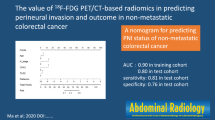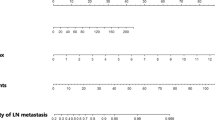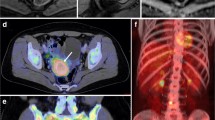Abstract
Purpose
To compare the diagnostic performance of qualitative and quantitative 18F-FDG PET/CT in detection of regional and distant lymph node metastasis in patients with anal cancer.
Methods
Between 2004 and 2017, 28 patients with anal cancer who had staging PET/CT and pathological assessment of suspicious lymph nodes were included. For qualitative analysis, positive lymph nodes were defined as uptake visually higher than the liver reference uptake. For quantitative study, lymph nodes were contoured to determine maximum standard uptake value (SUVmax) and metabolic tumor volume (MTV). Receiver operating characteristic (ROC) curves were plotted to extract the optimal cut-offs and area under the curve (AUC) of SUVmax, lesion to background (L/B) ratio, short axis diameter (SAD), and MTV of lymph nodes. Histopathologic analysis was a reference standard.
Results
A total of 28 lymph nodes (24 inguinal, 2 external iliac, 1 internal iliac, and 1 paraaortic nodes) in 28 patients on PET/CT were included. With the qualitative visual analysis, 19 patients were categorized as positive for nodal metastasis with sensitivity, specificity, and accuracy of 85%, 75%, and 82%. The optimal SUVmax and L/B ratio cut-offs were 2.6 and 1.0 with both sensitivity and specificity of 95% and 75% (AUC of SUVmax = 0.893, AUC of L/B ratio = 0.912). Using the best cut-off of 1.6 cm for SAD and 3.65 cm3 for MTV, both sensitivity and specificity were 80% and 100% (AUC of SAD = 0.950, AUC of MTV = 0.931).
Conclusions
SUVmax optimization may be helpful in enhancing the diagnostic accuracy of 18F-FDG PET/CT in nodal staging patients with anal cancer.



Similar content being viewed by others
References
Uronis HE, Bendell JC (2007) Anal cancer: an overview. The Oncologist 12:524–534. https://doi.org/10.1634/theoncologist.12-5-524
Anal Cancer - Cancer Stat Facts. https://seer.cancer.gov/statfacts/html/anus.html. Accessed 27 Feb 2018
(2012) Anal Cancer: Statistics. In: Cancer.Net. https://www.cancer.net/cancer-types/anal-cancer/statistics. Accessed 27 Feb 2018
Glynne-Jones R, Sebag-Montefiore D, Adams R, et al (2013) Prognostic factors for recurrence and survival in anal cancer: generating hypotheses from the mature outcomes of the first United Kingdom Coordinating Committee on Cancer Research Anal Cancer Trial (ACT I). Cancer 119:748–755. https://doi.org/10.1002/cncr.27825
Chawla AK, Willett CG (2001) Squamous cell carcinoma of the anal canal and anal margin. Hematol Oncol Clin North Am 15:321–344, vi
Scher ED, Ahmed I, Yue NJ, Jabbour SK (2014) Technical aspects of radiation therapy for anal cancer. J Gastrointest Oncol 5:198–211. https://doi.org/10.3978/j.issn.2078-6891.2014.026
RRyan DP, Compton CC, Mayer RJ (2000) Carcinoma of the anal canal. N Engl J Med 342:792–800. https://doi.org/10.1056/NEJM200003163421107
Glynne-Jones R, Nilsson PJ, Aschele C, et al (2014) Anal cancer: ESMO-ESSO-ESTRO clinical practice guidelines for diagnosis, treatment and follow-up. Eur J Surg Oncol J Eur Soc Surg Oncol Br Assoc Surg Oncol 40:1165–1176. https://doi.org/10.1016/j.ejso.2014.07.030
Gerard JP, Chapet O, Samiei F, et al (2001) Management of inguinal lymph node metastases in patients with carcinoma of the anal canal: experience in a series of 270 patients treated in Lyon and review of the literature. Cancer 92:77–84
Mohammadkhani Shali S, Schmitt V, Behrendt FF, et al (2016) Metabolic tumour volume of anal carcinoma on (18)FDG PET/CT before combined radiochemotherapy is the only independant determinant of recurrence free survival. Eur J Radiol 85:1390–1394. https://doi.org/10.1016/j.ejrad.2016.05.009
NCCN Clinical Practice Guidelines in Oncology. https://www.nccn.org/professionals/physician_gls/default.aspx#site. Accessed 3 Mar 2018
Saboo SS, Zukotynski K, Shinagare AB, et al (2013) Anal carcinoma: FDG PET/CT in staging, response evaluation, and follow-up. Abdom Imaging 38:728–735. https://doi.org/10.1007/s00261-012-9958-3
Mistrangelo M, Pelosi E, Bellò M, et al (2012) Role of Positron Emission Tomography-Computed Tomography in the Management of Anal Cancer. Int J Radiat Oncol 84:66–72. https://doi.org/10.1016/j.ijrobp.2011.10.048
Mistrangelo M, Pelosi E, Bellò M, et al (2010) Comparison of positron emission tomography scanning and sentinel node biopsy in the detection of inguinal node metastases in patients with anal cancer. Int J Radiat Oncol Biol Phys 77:73–78. https://doi.org/10.1016/j.ijrobp.2009.04.020
Caldarella C, Annunziata S, Treglia G, et al (2014) Diagnostic performance of positron emission tomography/computed tomography using fluorine-18 fluorodeoxyglucose in detecting locoregional nodal involvement in patients with anal canal cancer: a systematic review and meta-analysis. ScientificWorldJournal 2014:196068. https://doi.org/10.1155/2014/196068
Sveistrup J, Loft A, Berthelsen AK, et al (2012) Positron emission tomography/computed tomography in the staging and treatment of anal cancer. Int J Radiat Oncol Biol Phys 83:134–141. https://doi.org/10.1016/j.ijrobp.2011.06.1955
Bhuva NJ, Glynne-Jones R, Sonoda L, et al (2012) To PET or not to PET? That is the question. Staging in anal cancer. Ann Oncol Off J Eur Soc Med Oncol 23:2078–2082. https://doi.org/10.1093/annonc/mdr599
Wells IT, Fox BM (2012) PET/CT in anal cancer - is it worth doing? Clin Radiol 67:535–540. https://doi.org/10.1016/j.crad.2011.10.030
van Egmond SL, Piscaer V, Janssen LM, et al (2016) Influence of FDG-PET on primary nodal target volume definition for head and neck carcinomas. Acta Oncol Stockh Swed 55:1099–1106. https://doi.org/10.1080/0284186X.2016.1182643
Engstrom PF, Arnoletti JP, Benson AB, et al Anal Carcinoma. http://www.jnccn.org. Accessed 27 Feb 2018
Noorani A, Rabey N, Durrani A, et al (2013) Systematic review of sentinel lymph node biopsy in anal squamous cell carcinoma. Int J Surg 11:762–766. https://doi.org/10.1016/j.ijsu.2013.07.005
Lucignani G, Paganelli G, Bombardieri E (2004) The use of standardized uptake values for assessing FDG uptake with PET in oncology: a clinical perspective. Nucl Med Commun 25:651–656
Mohseni S, Shojaiefard A, Khorgami Z, et al (2014) Peripheral Lymphadenopathy: Approach and Diagnostic Tools. Iran J Med Sci 39:158–170
Kitajima K, Suenaga Y, Minamikawa T, et al (2015) Clinical significance of SUVmax in 18F-FDG PET/CT scan for detecting nodal metastases in patients with oral squamous cell carcinoma. SpringerPlus 4. https://doi.org/10.1186/s40064-015-1521-6
Dequanter D, Shahla M, Aubert C, et al (2015) Prognostic value of FDG PET/CT in head and neck squamous cell carcinomas. OncoTargets Ther 8:2279–2283. https://doi.org/10.2147/OTT.S85479
Bella AJE, Zhang Y-R, Fan W, et al (2014) Maximum standardized uptake value on PET/CT in preoperative assessment of lymph node metastasis from thoracic esophageal squamous cell carcinoma. Chin J Cancer 33:211–217. https://doi.org/10.5732/cjc.013.10039
Kumar A, Dutta R, Kannan U, et al (2011) Evaluation of mediastinal lymph nodes using 18F-FDG PET-CT scan and its histopathologic correlation. Ann Thorac Med 6:11–16. https://doi.org/10.4103/1817-1737.74270
Funding
This study was not funded.
Author information
Authors and Affiliations
Corresponding author
Ethics declarations
Conflict of interest
All authors declare that they have no conflict of interest.
Ethical approval
This article does not contain any studies with human participants performed by any of the authors. IRB statement: Institutional Review Board (IRB) and Health Insurance Portability and Accountability Act (HIPPA) approval were obtained and requirement for informed consent was waived by our hospital IRB.
Additional information
Publisher's Note
Springer Nature remains neutral with regard to jurisdictional claims in published maps and institutional affiliations.
Rights and permissions
About this article
Cite this article
Chulroek, T., Kordbacheh, H., Wangcharoenrung, D. et al. Comparative accuracy of qualitative and quantitative 18F-FDG PET/CT analysis in detection of lymph node metastasis from anal cancer. Abdom Radiol 44, 828–835 (2019). https://doi.org/10.1007/s00261-019-01907-6
Published:
Issue Date:
DOI: https://doi.org/10.1007/s00261-019-01907-6




